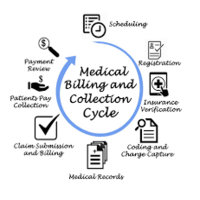Medical Billing and Coding: The Backbone of Healthcare Administration
Introduction
Medical Billing and Coding In the intricate world of healthcare, the seamless delivery of services hinges not only on medical expertise but also on efficient administrative processes. Among these, stand out as critical components that ensure healthcare providers are reimbursed accurately and promptly for their services. These processes bridge the gap between patient care and financial operations, playing a pivotal role in the sustainability of healthcare institutions.
1. Understanding Medical Billing and Coding
Medical billing and coding are distinct yet interconnected functions within the healthcare revenue cycle.
- Medical Coding: This involves translating healthcare diagnoses, procedures, medical services, and equipment into universal alphanumeric codes. These codes are derived from standardized coding systems such as:
- ICD-10-CM (International Classification of Diseases, 10th Revision, Clinical Modification): Used for diagnosing conditions.
- CPT (Current Procedural Terminology): Used for documenting medical, surgical, and diagnostic services.
- HCPCS (Healthcare Common Procedure Coding System): Used for services not covered by CPT codes, including certain drugs and medical equipment .
- Medical Billing: This process involves submitting claims to insurance companies and following up to ensure that healthcare providers receive payment for services rendered. It includes verifying patient insurance information, coding services accurately, and managing denied or rejected claims .
2. The Importance of Accurate
Accurate billing and coding are vital for several reasons:
- Financial Health of Healthcare Providers: Ensures timely and correct reimbursement, which is essential for the operational viability of healthcare institutions.
- Compliance with Regulations: Adherence to coding standards and billing practices helps in complying with healthcare laws and regulations, reducing the risk of audits and penalties .
- Patient Trust and Satisfaction: Transparent and accurate billing fosters trust between patients and providers, enhancing patient satisfaction and retention .
3. The Medical Billing and Coding Process
The process typically follows these steps:
- Patient Registration: Collecting and verifying patient information, including insurance details.
- Medical Coding: Translating healthcare services into appropriate codes.
- Charge Entry: Inputting coded information into the billing system.
- Claim Submission: Sending claims to insurance companies for reimbursement.
- Payment Posting: Recording payments received from insurers and patients.
- Accounts Receivable Follow-up: Monitoring unpaid claims and following up as necessary.
- Denial Management: Addressing and correcting denied or rejected claims to ensure payment .
4. Challenges in Medical Billing and Coding
Professionals in this field face several challenges:
- Complexity of Coding Systems: Navigating the vast number of codes and staying updated with changes can be daunting.
- Insurance Policies Variability: Different insurers have varying policies, making it challenging to ensure consistent reimbursement.
- Claim Denials: Handling denials and rejections requires expertise and can be time-consuming.
- Regulatory Compliance: Keeping abreast of ever-changing healthcare regulations and ensuring compliance is crucial .
5. The Role of Technology in Medical Billing and Coding
Advancements in technology have significantly impacted medical billing and coding:
- Electronic Health Records (EHRs): Streamline the documentation process, making it easier to extract coding information.
- Billing Software: Automates many aspects of billing, reducing errors and improving efficiency.
- Artificial Intelligence (AI): Assists in coding by analyzing clinical notes and suggesting appropriate codes.
- Data Analytics: Helps in identifying trends, improving billing practices, and reducing denials .
6. Career Opportunities in Medical Billing and Coding
The demand for skilled professionals in this field is growing. Career opportunities include:
- Medical Coders: Specialize in translating healthcare services into codes.
- Medical Billers: Focus on submitting and managing claims.
- Compliance Officers: Ensure adherence to healthcare regulations.
- Medical Billing and Coding Trainers: Educate and train new professionals in the field.
- Medical Billing and Coding Auditors: Review and ensure the accuracy of coding and billing practices.
Certifications from organizations like the AAPC (American Academy of Professional Coders) can enhance career prospects and credibility .
7. The Future of Medical Billing and Coding
The landscape of medical billing and coding is evolving:
- Increased Automation: More tasks are being automated, reducing manual errors and increasing efficiency.
- Integration with Other Healthcare Functions: Billing and coding are becoming more integrated with other aspects of healthcare administration.
- Focus on Value-Based Care: Shifting from volume-based to value-based care models requires adjustments in billing and coding practices.
- Global Standardization: Efforts are underway to standardize coding systems internationally, facilitating better data exchange and analysis.
Conclusion
Medical billing and coding are fundamental to the healthcare system, ensuring that providers are compensated for their services and that patients receive accurate billing information. As the healthcare industry continues to evolve, professionals in this field must adapt to new technologies, regulations, and practices to maintain efficiency and accuracy. Their role is indispensable in the seamless operation of healthcare delivery, impacting both the financial health of providers and the satisfaction of patients.
References
- Centers for Medicare & Medicaid Services. (2021). ICD-10-CM and ICD-10-PCS. Retrieved from https://www.cms.gov/Medicare/Coding
- American Medical Association. (2021). Current Procedural Terminology (CPT). Retrieved from https://www.ama-assn.org/delivering-care/public-health/cpt
- Centers for Medicare & Medicaid Services. (2021). Healthcare Common Procedure Coding System (HCPCS). Retrieved from https://www.cms.gov/Medicare/Coding
- American Academy of Professional Coders. (2021). AAPC Overview. Retrieved from https://www.aapc.com/
- Centers for Medicare & Medicaid Services. (2021). National Correct Coding Initiative. Retrieved from https://www.cms.gov/Medicare/Coding
